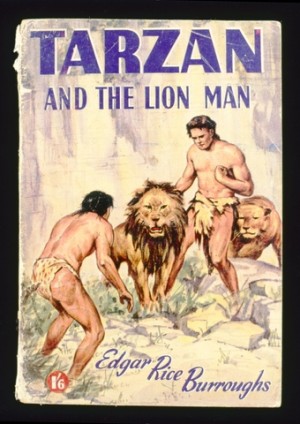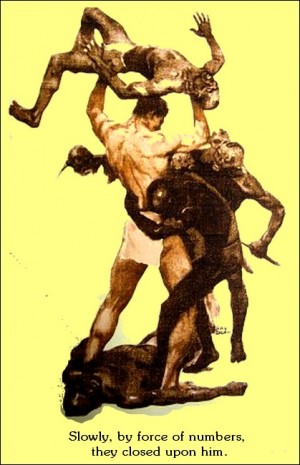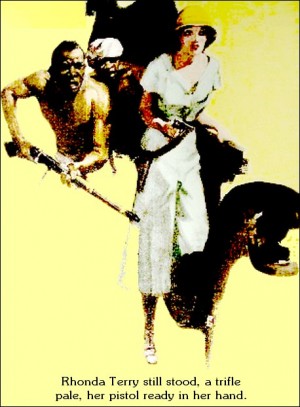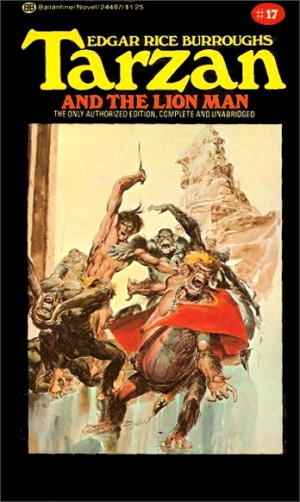 “It’s double the danger and double the fun.” If Tarzan and the Lion Man
had been adapted into a film back in the 30s that would certainly have
been the tagline. This is easily the most humorous of the Tarzan books,
sure there is always a bit of humor to found in books by Burroughs but
in this case Tarzan and the Lion Man is almost
a straight out comedy. With all the insane coincidences and mistaken
identities this could, at times, have been mistaken for a French farce.
Originally released in serialized form in the magazine Liberty
from November 1933 through January 1935, and at the time this book was
thought by the author to be the weakest one in the series, but I for one
think it is one of his best. Burroughs was not a fan of what Hollywood
had done to his most famous creation, making the Ape Man into an
illiterate savage, and this book works as a bit of an attack on the
industry.
“It’s double the danger and double the fun.” If Tarzan and the Lion Man
had been adapted into a film back in the 30s that would certainly have
been the tagline. This is easily the most humorous of the Tarzan books,
sure there is always a bit of humor to found in books by Burroughs but
in this case Tarzan and the Lion Man is almost
a straight out comedy. With all the insane coincidences and mistaken
identities this could, at times, have been mistaken for a French farce.
Originally released in serialized form in the magazine Liberty
from November 1933 through January 1935, and at the time this book was
thought by the author to be the weakest one in the series, but I for one
think it is one of his best. Burroughs was not a fan of what Hollywood
had done to his most famous creation, making the Ape Man into an
illiterate savage, and this book works as a bit of an attack on the
industry.The story opens with Milton Smith, executive VP of B.O. studio (Could B.O. stand for Box Office or perchance Body Odour?) as he greets director Tom Orman who he wishes to direct a movie on location in Africa. Major White, big game hunter and technical advisor for the production, doubts the ability of moving 27 tons of trucks and equipment to the jungle location Milton has picked.
Note: The same year this story was first published producer Merian C. Cooper would release King Kong, a story about a film production shooting on location in dangerous jungles. Burroughs has an Ape Man instead of Giant Ape.
Milton’s brilliant idea is a movie about a man raised by lions, “You see fellow’s born in the jungle and brought up by a lioness. He pals around with the lions all his life-he doesn’t know any other friends. The lion is the king of the beasts; when the boy grows up he’s king of the lions; so he bosses the whole menagerie. See? Big shot of the jungle.” The director’s one comment is, “Sounds familiar.” Later in the book’s epilogue we learn that several other studios are working on a Tarzan film, and several characters consider Tarzan to be just a made up story. This book comes very close to being meta.
The chief cast of characters in this book consist of Naomi Madison, the star of the picture, Rhonda Terry, who is Madison’s double, Bill West the cameraman, who is sweet on Rhonda, and Stanley Obroski, a marathon runner who has been cast to play the Lion Man. Naomi is in a relationship with Tom Orman but is also having an affair Obroski; that he has the looks and body of a Greek Adonis being the only real factor in this relationship as he is a complete coward and everyone knows it.
When the production treks through the dangerous Bansuto territory, ritual cannibals who take umbrage against any trespasser, they are routinely ambushed by the natives. Several porters, and even Major White, are killed during these attacks, and during these attacks Obroski could be found hiding under a truck, which makes him a pretty good match for Naomi who constantly faints at any sign of danger. Naomi is your typical Hollywood diva, she frequently puts down Rhonda’s acting ability which is clearly based on fear that her double is actually the better actor of the two, and she treats pretty much everyone like dirt.
Things go from bad to worse when a final attack causes all the native porters to desert the safari leaving just the film production and a group of Arab horsemen, led by Sheykh Ab El-Ghrennem, who had been hired to provide security for the safari. Then things even go further sideways when the production crew wake up one morning to find Sheykh Ab El-Ghrennem and his people gone as well, and that they had also abducted Naomi and Rhonda. The girls were grabbed because Ghrennem believes that this whole safari is searching for a lost city of diamonds, and that the scripted dialogue he heard, and a prop map he saw being used in the filming are all real, and if the mythical diamond city doesn’t exist he can at least sell the girls to a Black Sultan to recoup some of his losses. Unbeknownst to the production cast and crew is the fact that the prop map is actually the genuine article; the screenwriter found it inside an old book and incorporated it into the script. Orman and West decide to try and rescue the girls while the remaining members of the safari push onto the planned location.
And what is Tarzan doing during all this? Not much actually. He and the Golden Lion Jad-bal-ja are just hanging out in the jungle together, living life footloose and fancy free, he does occasionally swing by to spy on the safari, but never makes his presence known or even offer aid when they are attacked. This is another prime example of Tarzan’s personal code.
“He had seen something of the natives that inhabit this region. He had witnessed their methods of warfare against the whites who invaded their territory. His sympathies had been neither with one side nor the other. He had seen Orman, drunk lashing his black porters; and he felt that whatever misfortunes overtook him he deserved them.”
I’m sure if Jane was around Tarzan may have acted differently; done something to help them after getting a cold glare from his wife, but Jane is not around in this book so these poor saps are on their own for the first half of the book. Once again Tarzan’s moral code is neither human nor completely animal, and it often hinges on how bored he is. When Tarzan investigates a nearby Bansuto village, he likes to be well informed about the inhabitants of any territory he finds himself visiting, and he discovers a white man about to be ritually tortured and killed. This poor fellow turns out to be Stanley Obroski, who during one of the attacks on the safari fled like a coward into the long grass; unfortunately he ran straight into a group of Bansuto warriors and was captured. It’s here that we learn an interesting fact about Obroski, and that he is a dead ringer for Tarzan. If you can remember back in Tarzan and the Golden Lion we were introduced to Esteban Miranda, a Spanish actor/Tarzan lookalike, but where I found that character annoying and uninteresting I really enjoyed Stanley Obroski. He may have been a coward but not of the cruel variety, and when push comes to shove he does account himself fairly well. That Tarzan never remarks on the odds of two lookalikes arriving in Africa just goes to show you how bizarre and strange his life must be that nothing really surprises him anymore. That is until he eventually reaches the fabled city of diamonds and he meets talking gorillas.
One of the reasons for Tarzan intervening in the torturing of Obroski has to do with the Ape Man’s twisted sense of humor. When he sees this man, a man that is the spitting image of himself, he sneaks above the village and with a well thrown rope; he pulls the village chieftain up into the trees. The Chieftain is shocked to find himself in the clutches of the very man they were just about to kill below. That this man is in two places at once can only be explained by one thing, that he isn't a man but a demon. Tarzan uses this to good effect.
“I tested you to see if were a good man and your people good people. I made myself into two men, and one I sent where your warriors could capture him. I wanted to see what you would do to a stranger who had not harmed you. Now I know. For what you have done you should die.”
Tarzan is one crafty bastard. He is thus able to rescue Obroski without even having to throw a punch as the Chieftain is more than willing to let Obroski go, and he even promises to never harm another white person again. Tarzan tells Obroski that he had spotted Wells and Orman nearby, and leaving Obroski in the care of Jad-bal-ja, he goes off to find the man’s companions.
It’s here that we really see how much joy Tarzan has screwing with people. Earlier when he came across Wells and Orman, just as they were about to become lion chow, Tarzan dropped out of the trees and killed the lion, but then vanished back into the jungle without saying a word. This left Wells and Orman thinking they’d seen a ghost as they assumed Obroski was dead, and that coward certainly wouldn’t have attacked a lion let alone won the altercation. When Tarzan returns to Wells and Orman he continues to let them believe he is Obroski, for no other reason that it’s fun. Everyone who encounters Tarzan, thinking he is Obroski, are stunned with this change from coward to jungle god. This whole section of the book is brilliantly funny, and I haven’t even got to the crazy stuff yet.
So the aforementioned City of Diamonds is in fact real, and is populated by talking gorillas. Rhonda and Naomi escape from the clutches of the evil Arab horsemen, due to Rhonda’s spunky nature and smart thinking, but when a lion attacks the two are separated. Rhonda is captured by two gorillas that argue over whether to take her to Henry VIII, their gorilla king, or to their god. Needless to say she is a tad shocked to encounter gorillas that not only speak English but with a British accent as well, not to mention living in castles. More upsetting is that she learns Henry VIII will want her to be his wife.
Will Tarzan get to her in time? What has happened to Naomi, will she meet the same fate as her double? Can the production survive having all their cast killed or married off to apes? And just how exactly are there English speaking gorillas living in an Africa? Well if you’ve read H.G. Welles’s Island of Doctor Moreau you may have a good idea about that last one.
Much of this is Burroughs taking shots at the people in Hollywood, but not at the expense of the story or its characters. Naomi Madison moves from being a vein bitch to compassionate and strong character, and though Stanley Obroski is at first portrayed as an abject coward but later we learn more about him and gain some sympathy for the poor schmuck, not everyone can be Tarzan of the Apes. It’s in the book’s epilogue that we get the most satirical part of the story as Tarzan, in his John Clayton persona, visits Hollywood to find out what kind of place creates people like the ones he encountered. He even auditions for the part of Tarzan in a studio’s film production.
The casting director sized Clayton up. “You look all right to me; I’ll take you up to Mr. Goldstein; he’s production manager. Had any experience?”
“As Tarzan?”
The casting director laughed, “I mean in pictures.”
“No.”
“Well, you might be all right for that. You don’t have to be Barrymore to play Tarzan.”
Sadly Mr. Goldstein is not impressed, “Not the type,” he snapped. “Not the type at all.”
The amused Tarzan does take a small part as the “Great White Hunter” that the movie version of Tarzan is to save from a charging lion, but when the supposedly tame lion goes after the actor playing Tarzan the real Tarzan is forced to kill it. Is he thanked for saving a man’s life? No, he’s fired for killing an animal worth ten thousand dollars.
Tarzan’s visit to Hollywood is only a few pages long but it's so entertaining that one wishes Burroughs had made more stories with the Ape Man venturing into the supposed “civilized world” as this small excerpt was brilliant. This may be one of the books that doesn’t feature Tarzan as predominantly as others but damn is it fun. The comedy is spot on hilarious, never going completely into farce and Tarzan’s dry sarcastic whit is once again a highlight. Tarzan and the Lion Man is a must read for Tarzan fans.
Science Note: The talking gorillas in the City of Diamonds are a product of a mad scientist who fled persecution in England for his heretical views on genes and evolution. He set up shop in darkest Africa where he started experimenting with gene therapy on the resident gorillas. The apes did get smarter, and their young even developed vocal cords and the ability to speak. When the “Mad Scientist” realized old age was catching up with him he started injecting himself with gorilla DNA. Unfortunately though this did increase his longevity it also started giving him ape like physical characteristics. When Tarzan and Rhonda are captured he planned to inject himself with their DNA as well as eat them because he had discovered that eating the glands of a human speeds the process. If you’ve seen David Cronenberg’s The Fly you may recognize that was kind of the same plan that Seth Brundle had to regain his humanity.





No comments:
Post a Comment